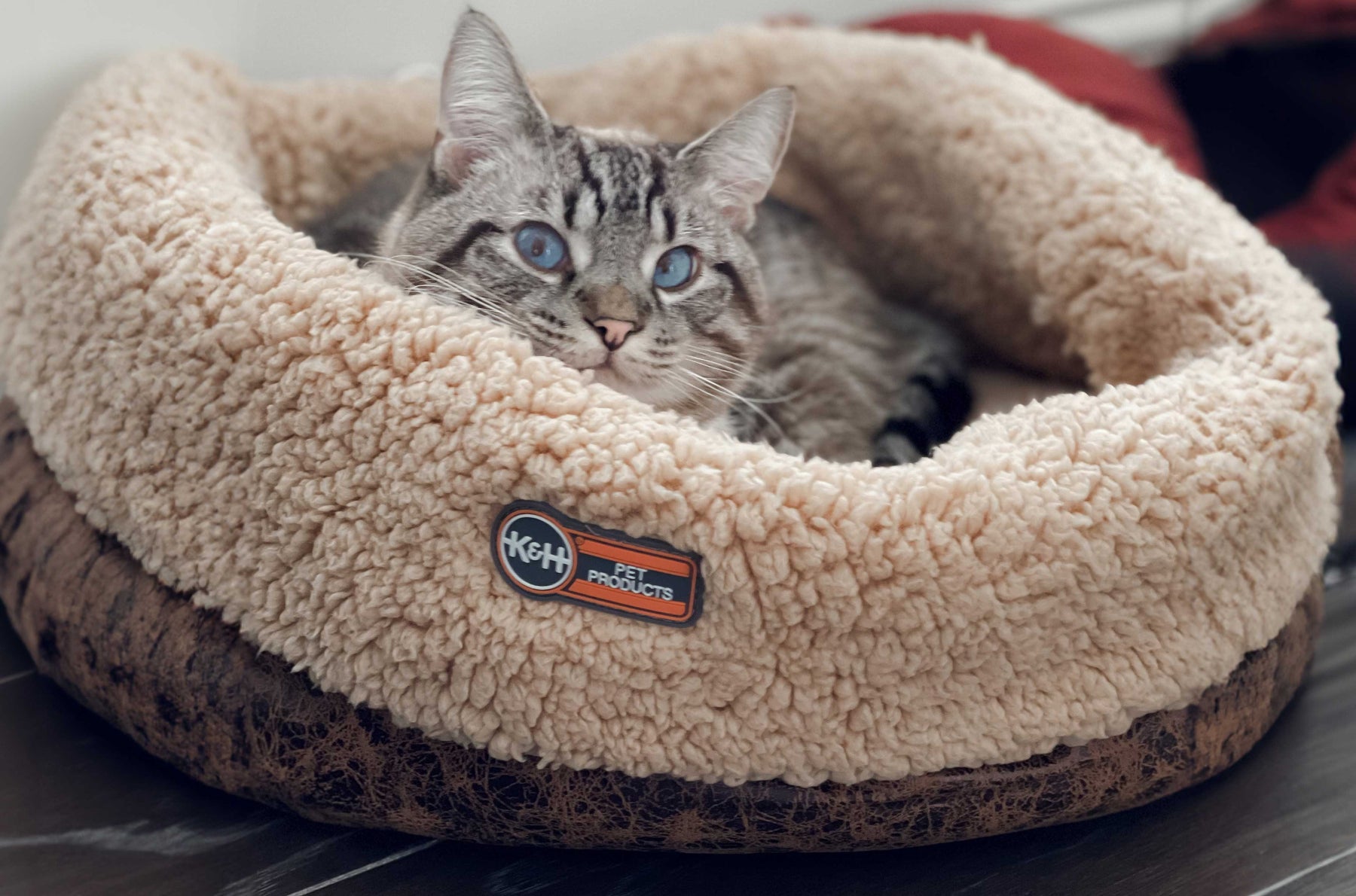
How to wash a cat bed
You've bought your precious kitty a brand-new bed. Instantly, your furry pal offers an approving purr and nestles into his new sleeping space. You beam with pride as you gaze at your content cat, slumbering on his crisp, clean bedding.

Of course, moments like these don't last forever. At some point, the newness of the bed will be replaced by strange smells and a furball or two. You know you need to wash it (probably sooner rather than later). And that gets you thinking: How often should I wash my cat's bed? How can I keep my furry friend's bed looking new?
Relax. You can do this! You only need to follow a few basic steps.
Know How Often to Wash Your Cat's Bed
How often you wash your cat's bedding depends on your cat's lifestyle and activities. For the most part, cats have exceptional hygienic habits. Because cats frequently bathe themselves, unwanted dirt and grime rarely stick around for long. So, if your kitty lives like a princess, you can probably wash your cat's bedding once a month. However, if your cat prefers venturing outdoors and playing with dead things, you may want to wash her bed once every week or two.
Like it or not, washing your cat's bedding is essential because pet beds can harbor dead skin, ticks, parasites, flea eggs and larvae — not to mention annoying odors. Keeping your cat's bed clean will also keep pet dander to a minimum which is healthier for you and your pet — especially for anyone suffering from allergies or asthma.
While washing your cat's bed regularly will help the bed last longer, be sure to wash with care. If washed improperly, the bed can look "tired" or even wear down more quickly.
Washing Tips to Keep Your Pet's Bed Looking New
- Remove excess hair. Remove as much hair as possible before washing your cat's bed. (You don't want to clog your washing machine's drain.) If your cat is an exceptional shedder, shake out any loose hair and remove any stubborn hair with your hand, vacuum or lint brush.
- Fight stubborn stains before washing. If you notice a stain, spot-treat it (gloves on if needed), and let it sit before washing. For a little extra attention, enzymatic sprays will help remove urine stains and odor. Cold water, white vinegar and baking soda can rid fabrics of blood stains and smells. If your cat's bedding is noticeably stinky, consider adding a cup of vinegar to the wash to fight stubborn odors. These stain and odor fighters work when machine or hand-washing most fabrics. Note: If you think bleach or ammonia would be good to remove stains, don't do it! Bleach reacts negatively with cat urine, and ammonia is a major component of cat urine. So, stick with enzymatic spot-on treatments and vinegar in the wash to treat stubborn stains on your cat's bed.
- Take note of label instructions. Carefully read factory labels before washing your cat's bed. Hand wash with a pet-friendly detergent if bedding cannot be machine washed. Don't worry; hand-washing is not very time-consuming.
- Go inside out. If your cat's bed has a removable cover, washing fabric inside out is an easy, often overlooked solution for keeping items looking new.
- Keep things simple. When selecting a detergent, less is more. Cats have an amazingly robust sense of smell compared to humans, and strong scents can be overpowering to a cat. Some cats will avoid a newly washed bed if it smells too fragrant. Choose a pet-friendly detergent (preferably free of fragrances and dyes) to avoid irritating your kitty's skin.
- Less is more. When selecting the washing setting, always choose the least-harsh option. The delicate and gentle cycles will treat fabrics with care and a softer touch. Also, washing in cold water versus hot will keep materials from fading.
- Dry with caution. While many manufacturer labels approve dryer use (usually on low or no heat), air or line dry to avoid unnecessary shrinkage and premature wear-and-tear.
Obviously, choosing a bed that's machine washable will make life a little easier for you. However, heated beds and beds with bolsters and other extras will require a little more hands-on care. So, if your cat needs extra support or heat, look for beds with a removable cover to make washing a cinch.
Washable Cat Bed Options
If you're looking to purchase a new cat bed or to replace one beyond help, we have a few easy-to-care-for options to consider.
Indoor Self-Warming Cat Beds
The K&H Self-Warming Kitty Bed Hooded is self-warming and offers soft walls to gently surround your furry friend. The soft polyfill cushion has a layer of metalized insulation that radiates warmth generated from your cat's own body. For easy washing, simply remove the cover and throw it into the wash.
The K&H Self-Warming Lounge Sleeper Pet Bed is made of an uber-soft microfleece and returns body heat to your kitty (no electricity needed), keeping him warm and snuggly while he relaxes. The Lounge Sleeper's fabric is machine washable, and you can either line-dry it or use a no-heat dryer setting.
If your cat enjoys sneaking off to get a bit of privacy, the K&H Self-Warming Hut creates a perfect getaway. No electricity is needed. This bed's metalized insulation cushion magically radiates heat back to your pet. And this bed is completely washable. To dry, you simply air or line dry.
Indoor Heated Beds
If you're looking for a soothing indoor cat bed to support joint health, consider a heated bed. Below are a few of our favorite options that are also easy to clean.
The K&H Thermo-Snuggle Cup Heated Cat Bed is purrfect for cats that love to nestle in for a nap. This bed's soft, comfy fleece surround will undoubtedly send any cat into dreamland. Its 4-watt heater is easily removable, so the entire bed can be machine washed.
The K&H Thermo-Kitty Bed Heated Cat Bed is ideal for a cat seeking a little privacy. The electric heated (4-watt, thermostatically controlled) bed will automatically warm your cat to her standard body temperature. The cover and cushion are easily removed and washed gently in cold water. Simply line-dry or throw it into a no-heat dryer.
The K&H Amazin' Thermo-Kitty Pad Heated Cat Bed is 100% polyester, which helps capture dander and shedding hair and is available in heated or non-heated options. With an easily removable internal warmer, this bed can be washed gently in cold water.
Outdoor Heated Cat Beds
If your cat prefers to sleep outside the comforts of home, such as a shed, barn, porch or garage, these beds will keep your precious kitty warm and snuggly when temperatures drop.
The K&H Deluxe Lectro-Soft Outdoor Heated Bed is the market's only outdoor heated bed that is also soft and has a bolster. This bed heats to your cat's standard body temperature. Its super-soft removable cover is machine washable and should be line-dried. While the bolster can't be washed, a damp towel or sponge with pet-friendly detergent will easily remove unwanted germs and stains.
The K&H Lectro-Soft Outdoor Heated Pet Bed Gray is a waterproof bed with a soft orthopedic foam base and a washable fleece cover. You can easily remove the cover to wash gently in cold water. Line-drying is best for this product. The bed portion cleans quickly with a damp towel or sponge and pet-friendly detergent.
The K&H Extreme Weather Heated Kitty Pad is ideal if you're looking for a simple, heated pad. This bed also heats up safely to your cat's standard temperature. Its super-soft, removable cover is machine washable and should be line-dried. The heated pad portion simply needs a wipe with a damp towel or sponge.
Washing Your Cat's Bed Is Simple with a Few Steps
Now that you know how to wash your cat's bed and how often, you should feel more informed and confident as you care for your kitty's bedding. Ultimately, it's all about your furry friend's needs and his overall health. Getting your hands a little dirty to ensure clean, healthy bedding helps everyone sleep a little better.




Leave a comment